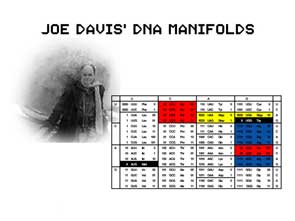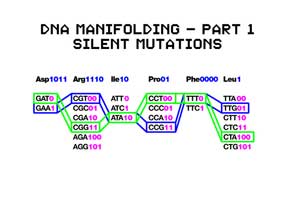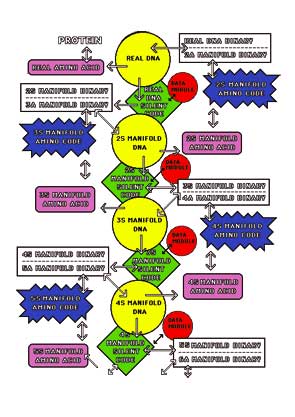 DNA Manfifolds are a discovery Joe Davis and use the
intrinsic possibilites of the genetic code to store
additional information within actual functioning DNA of an
organism, but without changing the genes (of this organism).
DNA Manfifolds are a discovery Joe Davis and use the
intrinsic possibilites of the genetic code to store
additional information within actual functioning DNA of an
organism, but without changing the genes (of this organism).
The 'central dogma' of molucular biology states the
information flow from DNA to RNA to amino acids to protein.
DNA can be seen as the storage of genetic information, RNA
as its transport mechanism, amino acids are the building
blocks of proteins, and protein are the results; the things,
that do the actual work.
DNA, the famous double helix, is made of a long string of 4
bases: adenine (A), guanine (G), cytosine (C) and thymine
(T).
Every codon, or base-triplett, of the DNA stands for an
amino acid. The base-tripletts are 3 bases long, which gives
a total number of 64 permutation: 4^3 or 4*4*4. (each digit
of each base-triplett can take either A, T, C or G)
The mapping of the 64 base-tripletts to only 20 amino acids
is known as the 'genetic code' and was only fully understood
in the late 60ies.
In most cases there are two or more base-tripletts, that
code for one amino acid.
For example, the base-tripletts CUU, CUC, CUA and CUG will
all produce the amino acids Leucine.
A change in the last digit will have no effect, as Leucine
will be produced in any way. This is called Silent Mutation.
Joe Davis' DNA Manifold method can be understood in two
parts: Silent Mutation and Recursion:
 First, it uses of this Silent Mutations by assigning a
binary value to each base-triplett. The information can be
encoded, only by changing the base-tripletts, the resulting
amino acid will not change.
First, it uses of this Silent Mutations by assigning a
binary value to each base-triplett. The information can be
encoded, only by changing the base-tripletts, the resulting
amino acid will not change.
 Secondly, binary values are also assigned to each amino
acid. This 'amino code' can be utilised to produce another,
'hypothetical' DNA sequence, by convering the joint amino
code sequence using the following key: 00 -> U, 01 -> C, 10
-> A, 11 -> T.
Secondly, binary values are also assigned to each amino
acid. This 'amino code' can be utilised to produce another,
'hypothetical' DNA sequence, by convering the joint amino
code sequence using the following key: 00 -> U, 01 -> C, 10
-> A, 11 -> T.
The same procedure can be applied again to the hypothetical
sequences over and over again.
Biopresence is collaborating with Joe Davis to incorporate
human DNA within the DNA of a tree, but without affecting
the genes of the resulting tree.

|